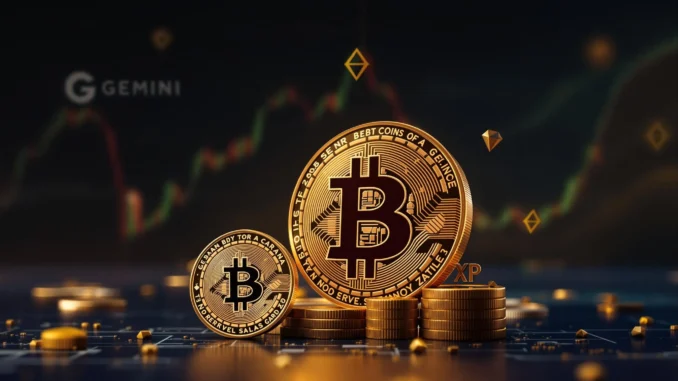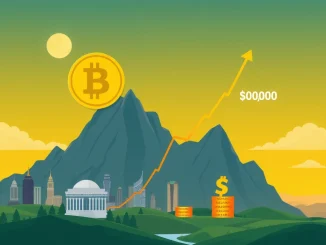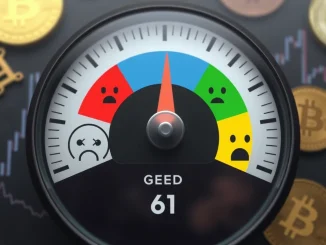
In a bold declaration that has ignited discussions across the crypto sphere, Gemini co-founder Tyler Winklevoss has firmly stated his stance on what constitutes a true digital reserve asset. Dismissing popular altcoins like XRP, Solana (SOL), and Cardano (ADA), Winklevoss unequivocally asserted that only one cryptocurrency currently fits the bill: Bitcoin. His comments, delivered via X (formerly Twitter), have sparked both agreement and debate, prompting a deeper look into what makes a digital asset suitable for reserve status. Let’s delve into Winklevoss’s perspective and unpack the nuances of this crucial discussion within the crypto market.
Why Bitcoin is King: The Reserve Asset Argument
Tyler Winklevoss’s statement wasn’t just a casual opinion; it was a deliberate assertion about the fundamental qualities needed for a cryptocurrency to function as a reserve asset. But what exactly does it mean for an asset to be considered a ‘reserve asset,’ especially in the context of the volatile cryptocurrency market? Traditionally, reserve assets are held by central banks and financial institutions to back liabilities and provide stability during economic uncertainties. In the crypto world, the concept is evolving, but the core principles remain similar: security, reliability, and established value.
Winklevoss highlighted that while he holds no personal animosity towards XRP, Solana, or Cardano, they simply don’t meet the stringent criteria for a strategic reserve asset right now. His emphasis on ‘right now’ suggests an acknowledgment of the dynamic nature of the crypto space, but his current conviction is clear: Bitcoin stands alone.
Unveiling the Criteria: What Makes a Crypto a Reserve Asset?
To understand Winklevoss’s viewpoint, we need to examine the characteristics that define a robust reserve asset. These can be broadly categorized into:
- Decentralization and Security: A true reserve asset should be resistant to censorship and control by any single entity. Its security infrastructure must be proven and robust, capable of withstanding attacks and maintaining network integrity.
- Longevity and Track Record: History matters. A reserve asset should have a proven track record of operating reliably over an extended period, demonstrating resilience through various market cycles.
- Liquidity and Market Depth: Deep liquidity ensures that large transactions can be executed without significantly impacting the price. A broad and active market is essential for a reserve asset to function effectively.
- Scarcity and Sound Monetary Policy: A predictable and limited supply is crucial to maintain value over time. A sound monetary policy, often algorithmically enforced, contributes to trust and long-term stability.
- Network Effects and Adoption: The more widely adopted and integrated an asset is into the financial ecosystem, the stronger its network effects become, reinforcing its value and utility.
Considering these factors, let’s analyze why Winklevoss might view Bitcoin as the sole contender and why he might see XRP, Solana, and Cardano differently.
Bitcoin: The Undisputed Champion of Crypto Reserve Assets?
Bitcoin, the pioneering cryptocurrency, often touted as ‘digital gold,’ possesses several attributes that align strongly with the criteria for a reserve asset:
- First-Mover Advantage and Longevity: Bitcoin has been operational since 2009, giving it a significant first-mover advantage and a decade-plus track record of resilience and operation. This longevity provides a level of trust and historical data that newer cryptocurrencies lack.
- Unmatched Decentralization: Bitcoin’s decentralized nature is arguably its most defining feature. Its network is distributed globally, making it highly resistant to censorship and single points of failure. This decentralization is a cornerstone of its security and appeal as a store of value.
- Proven Security and Network Robustness: Bitcoin’s blockchain has proven to be incredibly secure and robust over the years. Its proof-of-work consensus mechanism, while energy-intensive, has successfully secured the network against countless attacks.
- Established Scarcity: Bitcoin’s supply is capped at 21 million coins, a feature hardcoded into its protocol. This scarcity is a fundamental aspect of its value proposition, mirroring the scarcity of precious metals like gold.
- Deepest Liquidity and Market Cap: Bitcoin boasts the highest liquidity and market capitalization in the cryptocurrency market. This deep liquidity allows for large institutional investments and transactions, solidifying its position as a mature market.
These characteristics collectively position Bitcoin as a strong contender for the title of a digital reserve asset, particularly in the nascent and evolving world of cryptocurrencies.
XRP, Solana, and Cardano: Why Not Reserve Assets (Yet)?
While XRP, Solana, and Cardano are prominent and innovative cryptocurrencies, Winklevoss’s perspective suggests they may not yet possess the necessary attributes to be considered strategic reserve assets in the same vein as Bitcoin. Let’s examine some potential reasons:
XRP: Centralization Concerns and Regulatory Scrutiny
XRP, associated with Ripple Labs, has faced scrutiny regarding its level of centralization. Unlike Bitcoin’s fully decentralized nature, XRP’s creation and distribution are more closely tied to Ripple. Furthermore, Ripple’s ongoing legal battle with the SEC has cast a shadow over XRP, raising regulatory uncertainty. While XRP aims to facilitate cross-border payments and has partnerships with financial institutions, these factors might detract from its suitability as a long-term, universally accepted reserve asset.
Solana (SOL): Network Stability and Relative Newness
Solana is known for its high transaction speeds and scalability, making it a popular platform for decentralized applications (dApps) and DeFi. However, Solana’s network has experienced periods of instability and outages, raising concerns about its reliability as a foundational reserve asset. Additionally, compared to Bitcoin, Solana is a relatively newer cryptocurrency, lacking the extensive track record and battle-tested resilience of Bitcoin’s network.
Cardano (ADA): Development Stage and Adoption Curve
Cardano is a blockchain platform known for its focus on research-driven development and a layered architecture. While Cardano boasts technological advancements and a strong community, it is still in a phase of active development and broader adoption. Compared to Bitcoin’s established ecosystem and widespread integration, Cardano’s network effects and real-world usage are still evolving, potentially impacting its current viability as a widely recognized reserve asset.
It’s important to note that these are potential perspectives aligning with Winklevoss’s statement and are not definitive judgments on the long-term potential of XRP, Solana, or Cardano. The crypto landscape is constantly changing, and these projects are continuously evolving.
The Evolving Landscape of Crypto Reserve Assets
Winklevoss’s comments serve as a crucial reminder of the distinctions within the cryptocurrency market. While many cryptocurrencies offer innovative technologies and diverse use cases, the requirements for a true reserve asset are particularly stringent. Currently, Bitcoin, with its established history, decentralization, security, and market dominance, appears to be the frontrunner in this category.
However, the crypto space is dynamic. Projects like XRP, Solana, and Cardano are continuously developing, addressing challenges, and expanding their ecosystems. It’s conceivable that in the future, as these projects mature and the crypto market evolves, the landscape of digital reserve assets could broaden. Regulatory clarity, technological advancements, and increased adoption will all play pivotal roles in shaping this future.
Actionable Insights: Navigating the Crypto Reserve Asset Discussion
So, what can we glean from Winklevoss’s statement and this discussion?
- Understand the Nuances: Recognize that not all cryptocurrencies are created equal. Different cryptocurrencies serve different purposes and possess varying degrees of maturity, security, and decentralization.
- Focus on Fundamentals for Reserve Assets: When considering an asset for reserve status, prioritize factors like decentralization, longevity, security, liquidity, and scarcity.
- Bitcoin’s Current Dominance: Acknowledge Bitcoin’s current position as the most established and arguably most suitable cryptocurrency for reserve asset consideration, based on current criteria.
- Monitor Evolving Crypto Landscape: Stay informed about the development and progress of other cryptocurrencies like XRP, Solana, and Cardano. The crypto market is constantly evolving, and future assessments may differ.
- Do Your Own Research (DYOR): Form your own informed opinions by conducting thorough research on different cryptocurrencies and their suitability for various purposes, including potential reserve asset status.
Conclusion: Bitcoin’s Enduring Appeal as a Digital Reserve
Tyler Winklevoss’s assertion underscores the unique position Bitcoin holds within the cryptocurrency ecosystem. While the crypto market offers a diverse range of assets, the rigorous criteria for a strategic reserve asset currently point towards Bitcoin as the most compelling choice. Its proven track record, decentralized nature, robust security, and established market presence provide a foundation unmatched by other cryptocurrencies at this time. As the crypto landscape continues to mature, the definition and landscape of digital reserve assets may evolve, but for now, Bitcoin confidently wears the crown, at least in the eyes of prominent figures like Tyler Winklevoss. This declaration serves as a powerful reminder of the fundamental principles that underpin the value and utility of cryptocurrencies, particularly when considering their role as potential stores of value and reserve assets in the digital age.



